Climate Change Effects on Belgian Households: A Case Study of a Nearly Zero Energy Building
Abstract
1. Introduction
2. Future Weather Data for Building Performance Simulation
3. Materials and Methods
3.1. Future Weather Data
- RCP 4.5: Strategies for reducing greenhouse gas emissions cause radiative forcing to stabilize at 4.5 W/m2 before the year 2100.
- RCP 6: emissions peak and radiative forcing will reach 6 W/m2 around 2080 and then decline.
- RCP 8.5: Increased greenhouse gas emissions mean that radiative forcing will reach 8.5 W/m2 by the year 2100.
3.2. Case Study
3.3. Building Energy Modeling and Calibration
3.4. Thermal Comfort Modeling
4. Results
4.1. Climate Change Impact on Thermal Comfort
4.2. Future Scenarios against Different Comfort Models
4.3. Models Validation
5. Discussion
6. Conclusions
Author Contributions
Funding
Acknowledgments
Conflicts of Interest
References
- Elrawy, O.O.; Attia, S. The impact of climate change on Building Energy Simulation (BES) uncertainty-Case study from a LEED building in Egypt. IOP Conf. Ser. Earth Environ. Sci. 2019, 397, 012005. [Google Scholar] [CrossRef]
- Gaterell, M.R.; McEvoy, M. The impact of climate change uncertainties on the performance of energy efficiency measures applied to dwellings. Energy Build. 2005, 37, 982–995. [Google Scholar] [CrossRef]
- Vardoulakis, S.; Dimitroulopoulou, C.; Thornes, J.; Lai, K.M.; Taylor, J.; Myers, I.; Heaviside, C.; Mavrogianni, A.; Shrubsole, C.; Chalabi, Z.; et al. Impact of climate change on the domestic indoor environment and associated health risks in the UK. Environ. Int. 2015, 85, 299–313. [Google Scholar] [CrossRef]
- Attia, S. Net Zero Energy Buildings (NZEB): Concepts, Frameworks and Roadmap for Project Analysis and Implementation; Butterworth-Heinemann: Oxford, UK, 2018. [Google Scholar]
- Hamdy, M.; Carlucci, S.; Hoes, P.-J.; Hensen, J.L. The impact of climate change on the overheating risk in dwellings—A Dutch case study. Build. Environ. 2017, 122, 307–323. [Google Scholar] [CrossRef]
- Berardi, U.; Jafarpur, P. Assessing the impact of climate change on building heating and cooling energy demand in Canada. Renew. Sustain. Energy Rev. 2020, 121, 109681. [Google Scholar] [CrossRef]
- Jylhä, K.; Jokisalo, J.; Ruosteenoja, K.; Pilli-Sihvola, K.; Kalamees, T.; Seitola, T.; Mäkelä, H.M.; Hyvönen, R.; Laapas, M.; Drebs, A. Energy demand for the heating and cooling of residential houses in Finland in a changing climate. Energy Build. 2015, 99, 104–116. [Google Scholar]
- Yang, Y.; Nik, V.M. Assessing the impacts of climate change on the German building stock. In Proceedings of the 16th IBPSA Conference, Italy, Rome, 2–4 September 2019; pp. 3563–3570. [Google Scholar]
- Ramon, D.; Allacker, K.; van Lipzig, N.P.; De Troyer, F.; Wouters, H. Future Weather Data for Dynamic Building Energy Simulations: Overview of Available Data and Presentation of Newly Derived Data for Belgium. In Energy Sustainability in Built and Urban Environments; Springer: Berlin/Heidelberg, Germany, 2019; pp. 111–138. [Google Scholar]
- Attia, Goede praktijken voor zonwering en EPB-berekening, Expert day Zomercomfort Pixii—Passiefhuis-Platform, Gent, Belgium, 10 October 2020. Available online: https://orbi.uliege.be/handle/2268/251437 (accessed on 14 October 2020).
- KMI. Klimaatverandering: Waarnemingen in België. Available online: https://www.klimaat.be/nl-be/klimaatverandering/belgie/waarnemingen-belgie (accessed on 2 October 2020).
- Moazami, A.; Nik, V.; Carlucci, S.; Geving, S. Impacts of the future weather data type on the energy simulation of buildings–Investigating long-term patterns of climate change and extreme weather conditions. Appl. Energy 2019, 238, 696–720. [Google Scholar] [CrossRef]
- Stocker, T.F.; Qin, D.; Plattner, G.-K.; Tignor, M.; Allen, S.K.; Boschung, J.; Nauels, A.; Xia, Y.; Bex, V.; Midgley, P.M. Climate change 2013: The physical science basis. In Contribution of Working Group I to the Fifth Assessment Report of the IPCC; IPCC: Geneva, Switzerland, 2013; p. 1535. [Google Scholar]
- Ehret, U.; Zehe, E.; Wulfmeyer, V.; Warrach-Sagi, K.; Liebert, J. HESS Opinions “Should we apply bias correction to global and regional climate model data?”. Hydrol. Earth Syst. Sci. Discuss. 2012, 9. [Google Scholar] [CrossRef]
- Haddeland, I.; Heinke, J.; Voß, F.; Eisner, S.; Chen, C.; Hagemann, S.; Ludwig, F. Effects of climate model radiation, humidity and wind estimates on hydrological simulations. Hydrol. Earth Syst. Sci. 2012, 16, 305–318. [Google Scholar] [CrossRef]
- Giorgi, F.; Gutowski, W.J., Jr. Regional dynamical downscaling and the CORDEX initiative. Annu. Rev. Environ. Resour. 2015, 40, 467–490. [Google Scholar] [CrossRef]
- Nik, V. Making energy simulation easier for future climate–Synthesizing typical and extreme weather data sets out of regional climate models (RCMs). Appl. Energy 2016, 177, 204–226. [Google Scholar] [CrossRef]
- Wyard, C. Climate Change in Belgium: Recent and Future Evolution of Global Radiation and Hydroclimatic Conditions Favouring Floods Using the Regional Climate Model MAR. Ph.D. Thesis, Université de Liège, Liège, Belgique, 2018. [Google Scholar]
- Meester, T.D. Etude du Comportement Thermique et Energétique d’une Maison Passive par Modélisation Dynamique. MSc Thesis, Université Catholique de Louvain, Ottignies-Louvain-la-Neuve, Belgium, 2008. [Google Scholar]
- Gobin, C. Bâtiments D’aujourd’hui, Climat de Demain: Évaluation de L’impact du Réchauffement Climatique sur le Confort Thermique et L’efficacité Energétique d’un Bâtiment Résidentiel Passif Existant en Belgique. Master’s Thesis, Université de Liège, Liège, Belgique, 2016. [Google Scholar]
- Wyard, C.; Fettweis, X. The MAR Model Performances over Belgium. Ph.D. Thesis, Liege University, Liège, Belgium, 2016. [Google Scholar]
- Pachauri, R.K.; Allen, M.R.; Barros, V.R.; Broome, J.; Cramer, W.; Christ, R.; Church, J.A.; Clarke, L.; Dahe, Q.; Dasgupta, P.; et al. Climate Change 2014: Synthesis Report. Contribution of Working Groups I, II and III to the Fifth Assessment Report of the Intergovernmental Panel on Climate Change; IPCC: Geneva, Switzerland, 2014. [Google Scholar]
- Wyard, C.; Doutreloup, S.; Belleflamme, A.; Wild, M.; Fettweis, X. Global radiative flux and cloudiness variability for the Period 1959–2010 in Belgium. Atmosphere 2018, 9, 262. [Google Scholar] [CrossRef]
- Kottek, M.; Grieser, J.; Beck, C.; Rudolf, B.; Rubel, F. World map of the Köppen-Geiger climate classification updated. Meteorol. Z. 2006, 15, 259–263. [Google Scholar] [CrossRef]
- Mlecnik, E.; Attia, S.; Van Loon, S. Net zero energy building: A review of current definitions and definition development in Belgium. Passiv. House Symp. 2011. Available online: http://www.task42.iea-shc.org/data/sites/1/publications/T40B3.1-Net_zero_energy_building-A_review_of_current_definitions_and_definition_development_in_Belgium_PHS2011.pdf (accessed on 15 June 2020).
- Une Maison à Ossature Bois Projet: Habitation à KETTENIS. 2007. Available online: http//energie.wallonie.be (accessed on 15 June 2020).
- Hauglustaine, J.M.; Michaelis, L. Méthode graphique d’optimisation de la consommation de chauffage et du risque de surchauffe: application à une maison presque passive. In Proceedings of the Symposium “Passief Huis Happening”, Alost, Belgium, 21 October 2005. [Google Scholar]
- Tindale, A. Designbuilder Software; Design-Builder Software Ltd.: Stroud, UK, 2020. [Google Scholar]
- Pérez-Fargallo, A.; Pulido-Arcas, J.A.; Rubio-Bellido, C.; Trebilcock, M.; Piderit, B.; Attia, S. Development of a new adaptive comfort model for low income housing in the central-south of Chile. Energy Build. 2018, 178, 94–106. [Google Scholar] [CrossRef]
- Attia, S.; Carlucci, S. Impact of different thermal comfort models on zero energy residential buildings in hot climate. Energy Build. 2015, 102, 117–128. [Google Scholar] [CrossRef]
- Jones, M.C. Kumaraswamy’s distribution: A beta-type distribution with some tractability advantages. Stat. Methodol. 2009, 6, 70–81. [Google Scholar] [CrossRef]
- Narayan, A.; Ponnambalam, K. Risk-averse stochastic programming approach for microgrid planning under uncertainty. Renew. Energy 2017, 101, 399–408. [Google Scholar] [CrossRef]
- ASHRAE. Standard Method of Test for the Evaluation of Building Energy Analysis Computer Programs; American Society of Heating, Refrigerating and Air-Conditioning Engineers, Inc.: Atlanta, GA, USA, 2001; Volume 140. [Google Scholar]
- Judkoff, R.; Neymark, J. Model Validation and Testing: The Methodological Foundation of ASHRAE Standard 140; National Renewable Energy Lab. (NREL): Golden, CO, USA, 2006. [Google Scholar]
- Gauvreau-Lemelin, C.; Attia, S. Benchmarking the environmental impact of green and traditional masonry wall constructions. Available online: https://orbi.uliege.be/bitstream/2268/212318/1/PLEA2017%20Paper.pdf (accessed on 15 June 2020).
- Amer, M.; Attia, S. Identification of sustainable criteria for decision-making on roof stacking construction method. Sustain. Cities Soc. 2019, 47, 101456. [Google Scholar] [CrossRef]
- Caluwaerts, S.; Termonia, P.; Hamdi, R.; Duchêne, F.; Berckmans, J.; Degrauwe, D.; Wauters, G. Monitoring the urban climate of the city of Ghent, Belgium. Urban Clim. News 2016, 61, 15–20. [Google Scholar]
- Singh, M.K.; Attia, S.; Mahapatra, S.; Teller, J. Assessment of thermal comfort in existing pre-1945 residential building stock. Energy 2016, 98, 122–134. [Google Scholar] [CrossRef]
- O’Neill, B.C.; Tebaldi, C.; Van Vuuren, D.P.; Eyring, V.; Friedlingstein, P.; Hurtt, G.; Knutti, R.; Kriegler, E.; Lamarque, J.F.; Lowe, J.; et al. The scenario model intercomparison project (ScenarioMIP) for CMIP6. Geosci. Model Dev. 2016, 9, 3461–3482. [Google Scholar] [CrossRef]
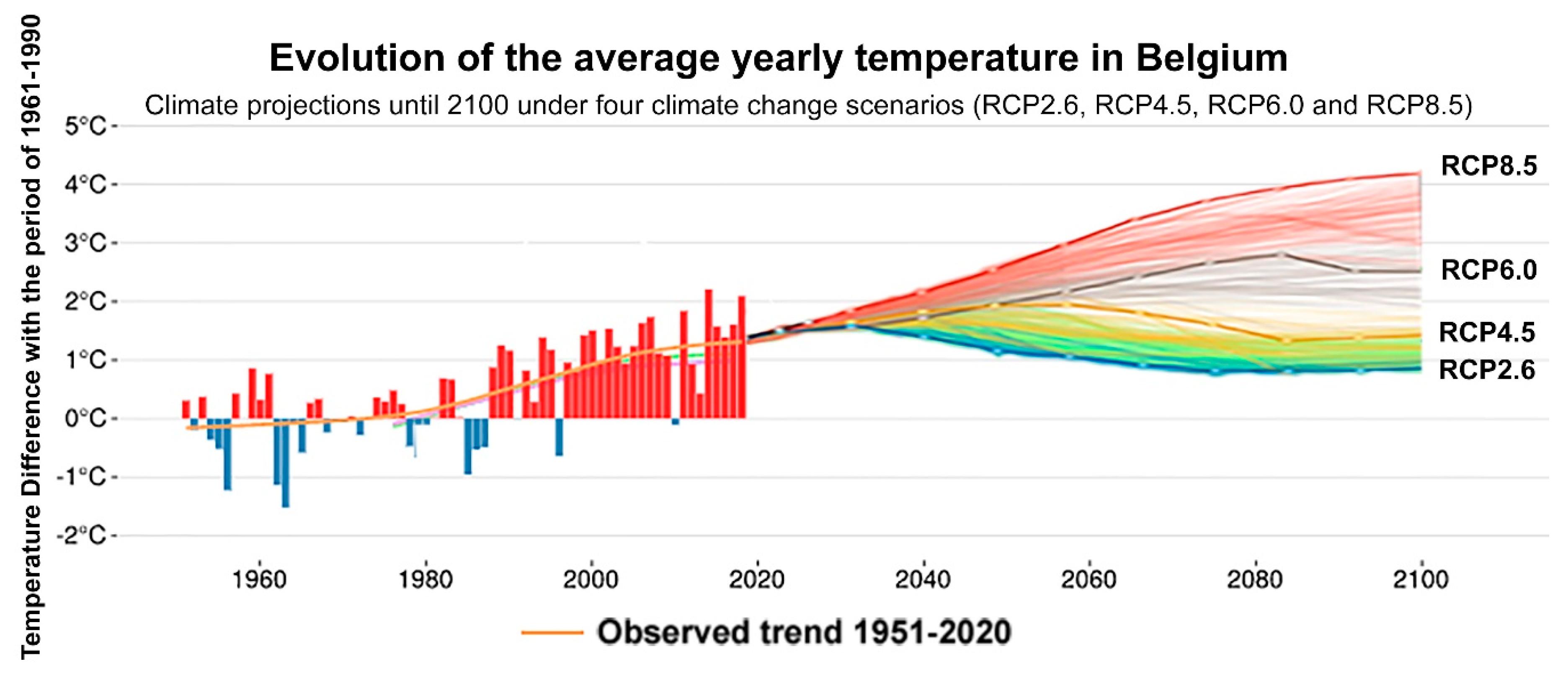
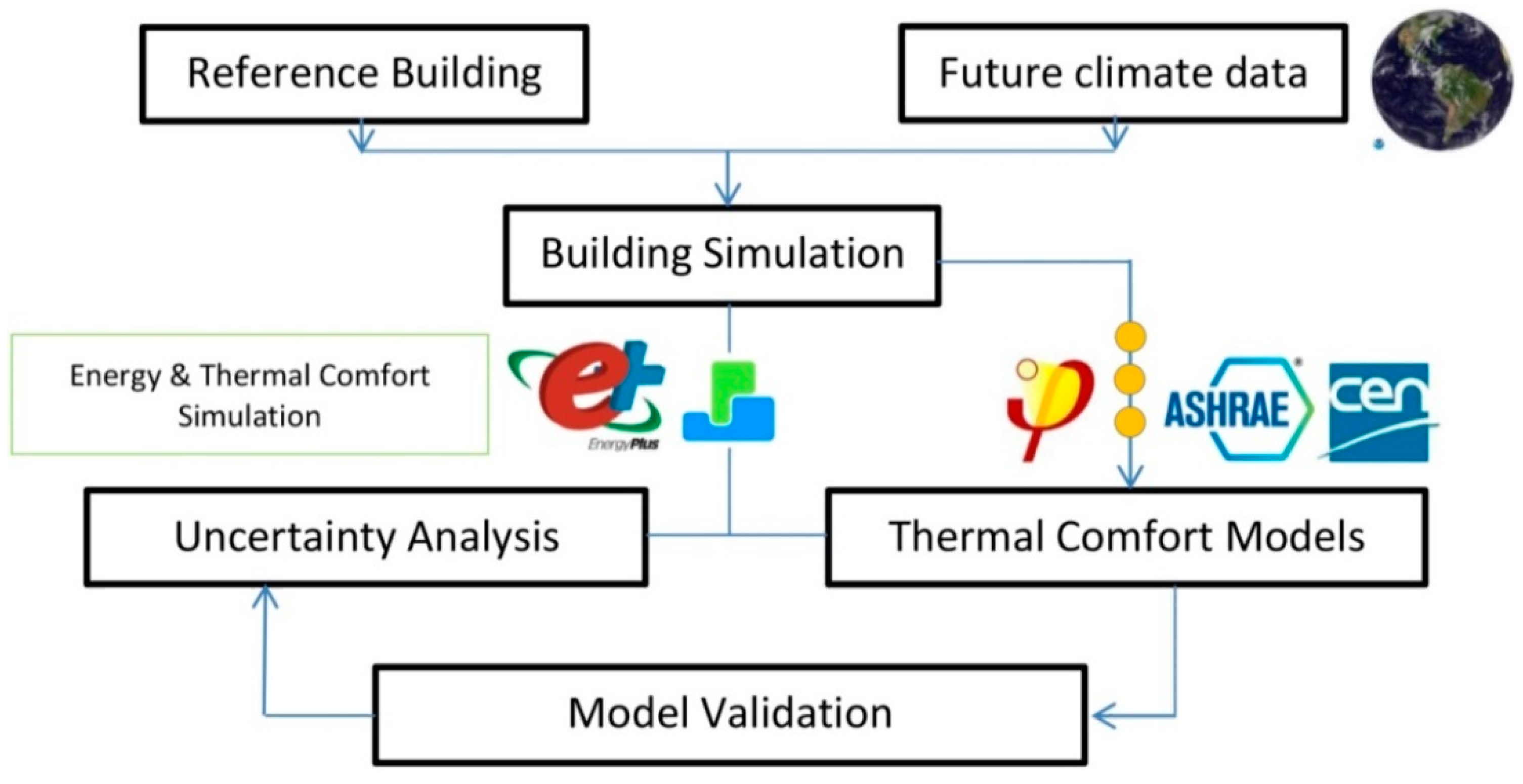


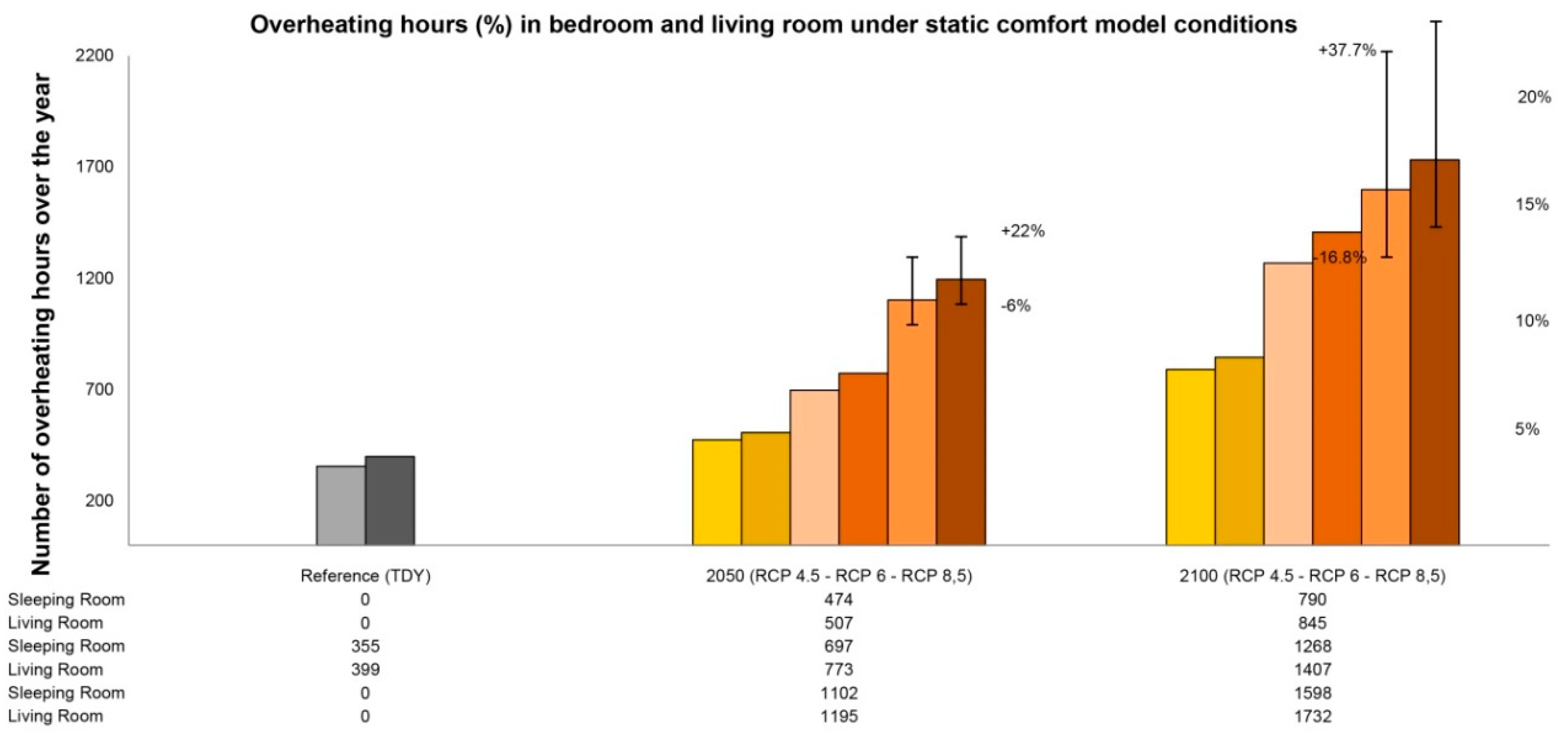
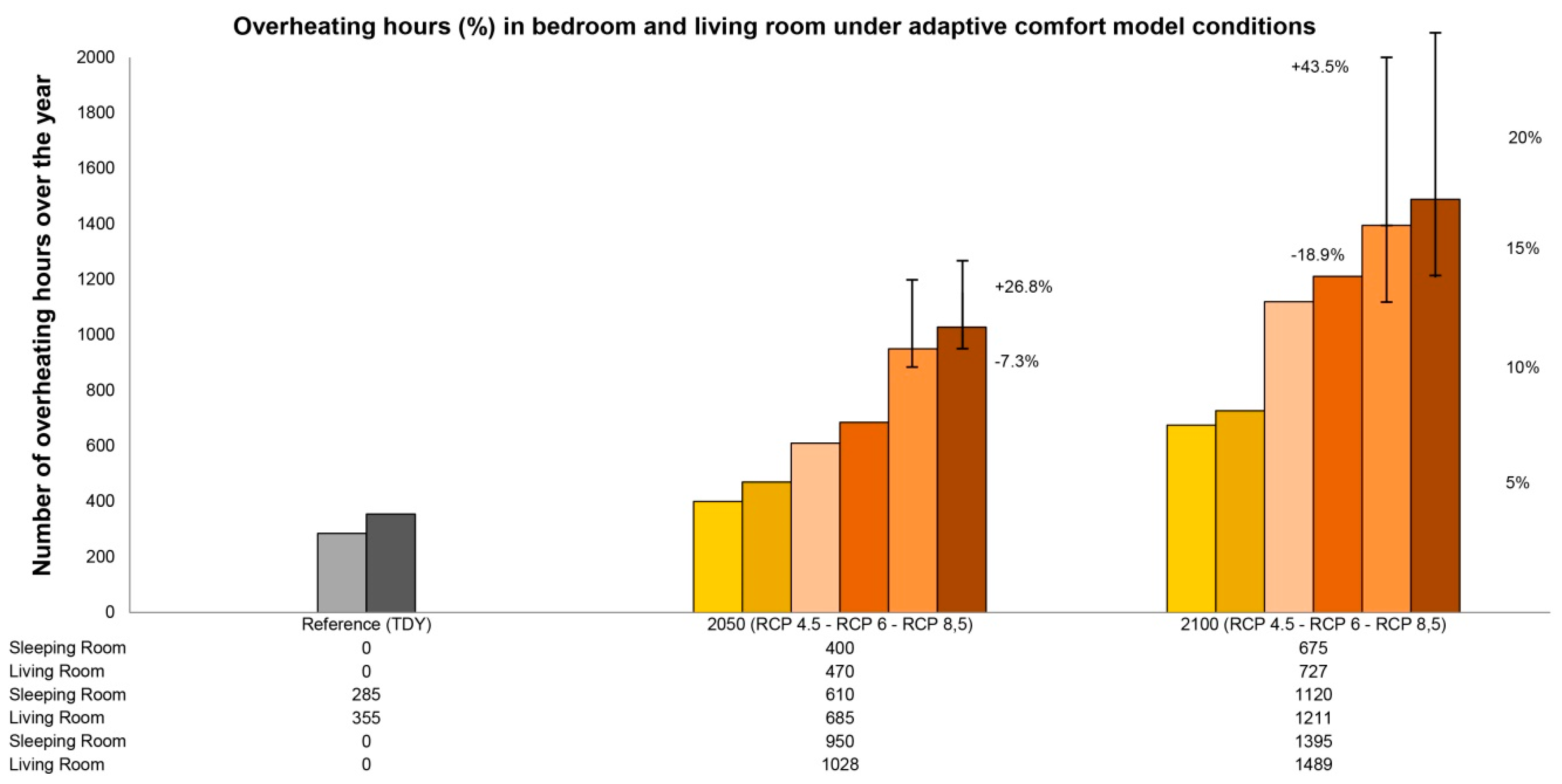
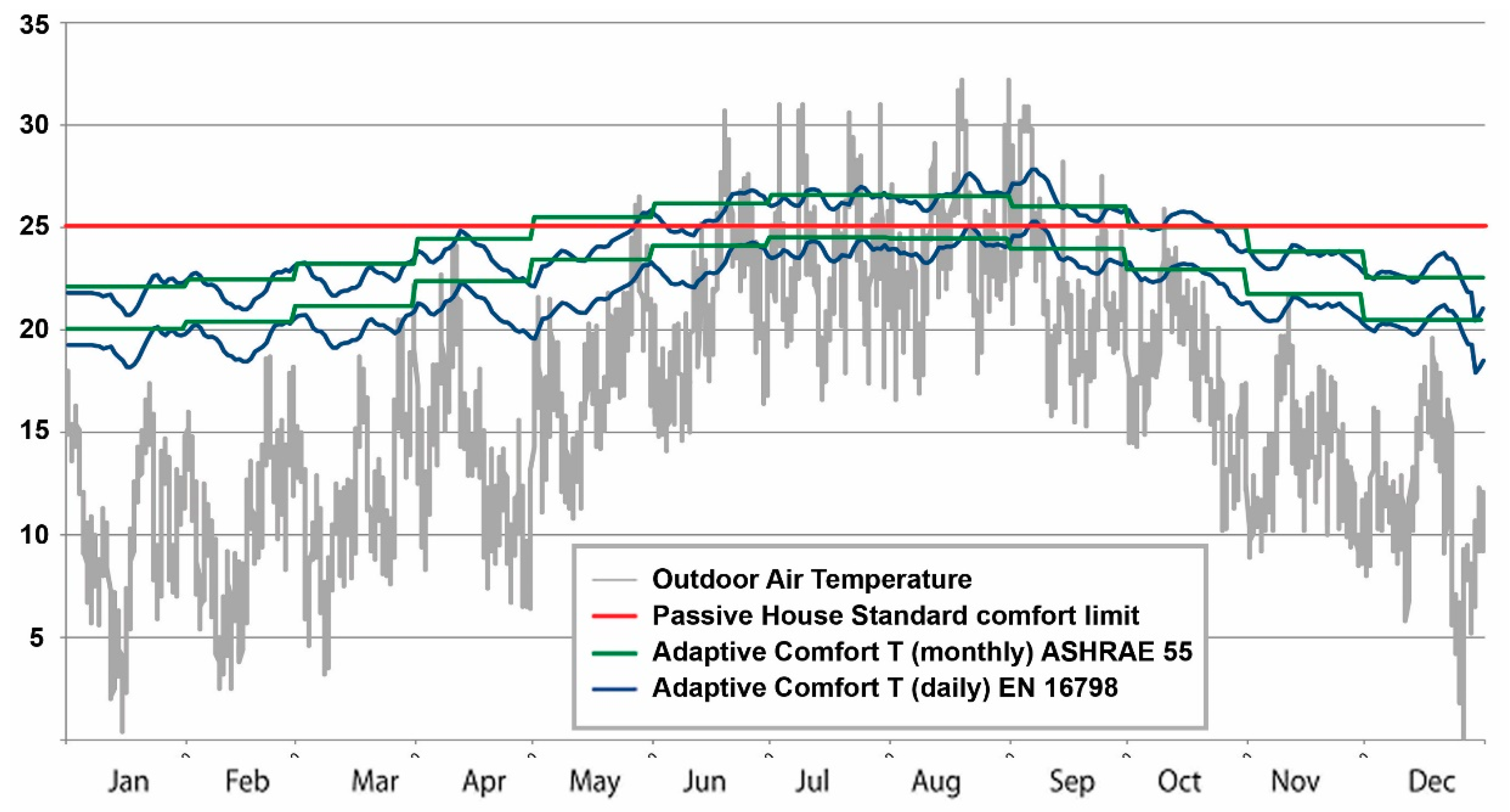
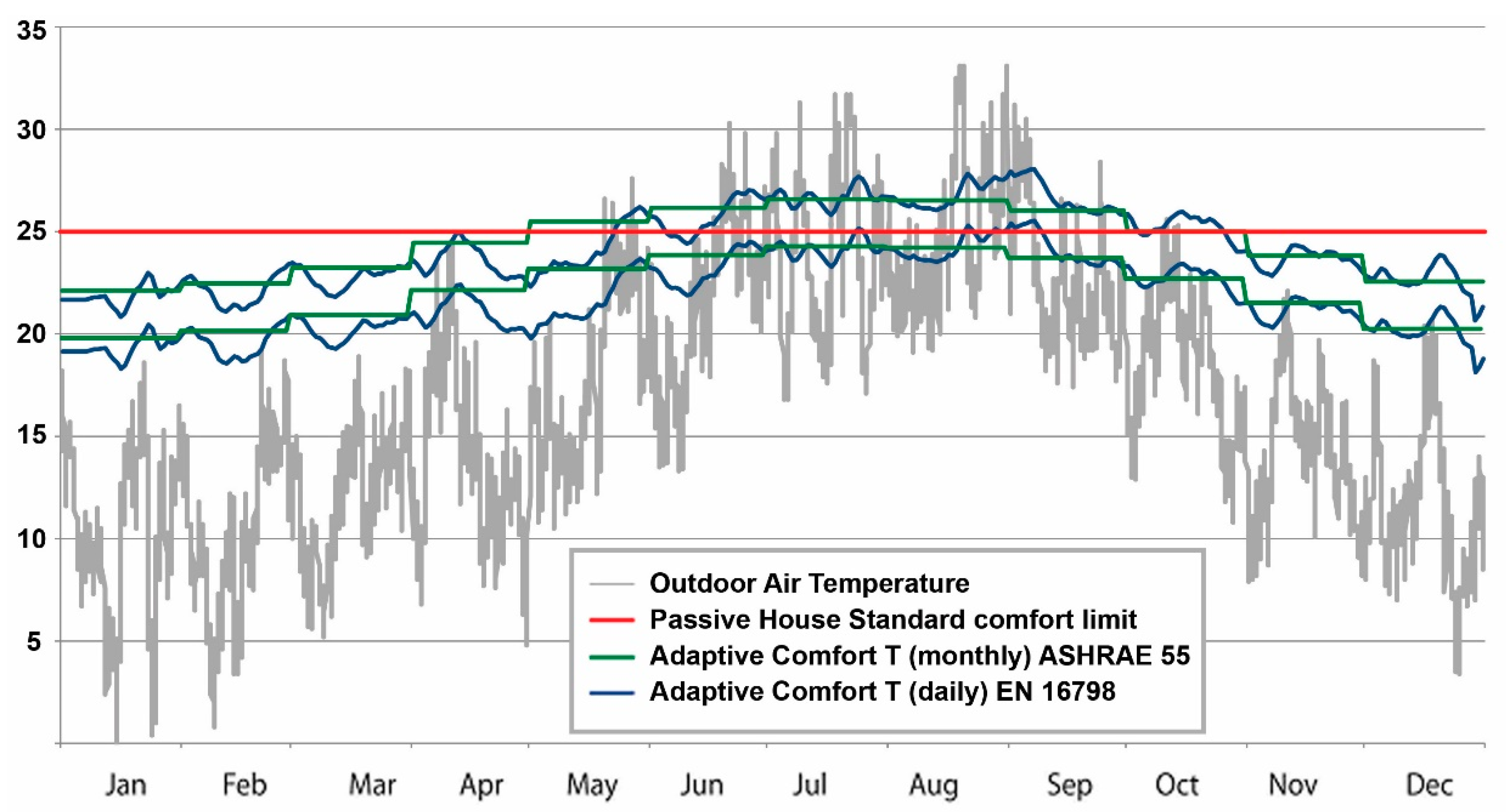
© 2020 by the authors. Licensee MDPI, Basel, Switzerland. This article is an open access article distributed under the terms and conditions of the Creative Commons Attribution (CC BY) license (http://creativecommons.org/licenses/by/4.0/).
Share and Cite
Attia, S.; Gobin, C. Climate Change Effects on Belgian Households: A Case Study of a Nearly Zero Energy Building. Energies 2020, 13, 5357. https://doi.org/10.3390/en13205357
Attia S, Gobin C. Climate Change Effects on Belgian Households: A Case Study of a Nearly Zero Energy Building. Energies. 2020; 13(20):5357. https://doi.org/10.3390/en13205357
Chicago/Turabian StyleAttia, Shady, and Camille Gobin. 2020. "Climate Change Effects on Belgian Households: A Case Study of a Nearly Zero Energy Building" Energies 13, no. 20: 5357. https://doi.org/10.3390/en13205357
APA StyleAttia, S., & Gobin, C. (2020). Climate Change Effects on Belgian Households: A Case Study of a Nearly Zero Energy Building. Energies, 13(20), 5357. https://doi.org/10.3390/en13205357





